Morten Skallerud In Conversation |
Read more at in70mm.com The 70mm Newsletter |
| Interview and photography by: Thomas Hauerslev, September 2018 in Karlsruhe, Germany. Transcribed from audio recordings by: Mark Lyndon, London, UK. Edited for continuity and clarity by: Morten Skallerud, Oslo, Norway. | Date: 10.03.2019 |
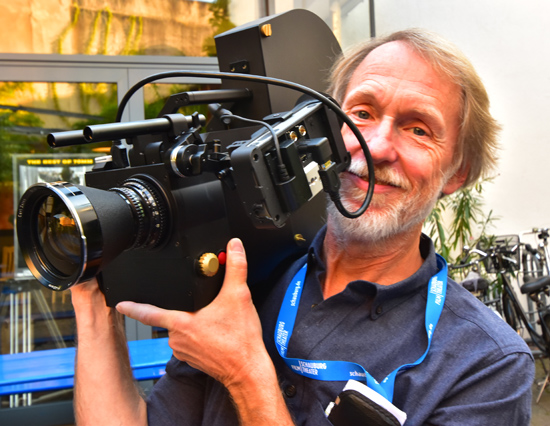 Morten
Skallerud in Karlsruhe, September 2018 posing with the Danish Magellan 65mm
camera. Morten
Skallerud in Karlsruhe, September 2018 posing with the Danish Magellan 65mm
camera.Thomas Hauerslev: In your own words, how would you describe "A Year Along the Abandoned Road"? Morten Skallerud: Well it's basically a portrait of a place. I think about this film as a documentary more than as an animation film. It's a documentary very specifically about that place - Børfjord - which is high up in northern Norway. We used the stop frame animation technique because it was the best way to make the film. I am a person who thinks very much in terms of visual and special effects. That is why we did it like we did. With that animation technique, which can be called nature animation, we could combine doing time lapse and revealing the whole place as we moved through it. It would have been impossible to do anything like that and get the same effect if we shot the film live. Basically, the film is a documentary portrait of the place Børfjord, shot with an animation technique. THa: How far away is Børfjord? Morten: It is almost as far north as you can get in Norway. It lies on Norway's fourth largest island Sørøya, which is off the coast of Northern Norway, near Hammerfest. It's a little bit further south than North Cape but not very much further south. THa: Is it easy to reach for tourists? Morten: No. It's difficult to get there. Either you need a boat, or you can take a car to the nearest inhabited place which is Breivikbotn. In the summer, you can also drive on to the neighbouring fjord Dønnesfjord, then you have to either walk on foot, or take another boat, to the place, or in winter you can go on a snow scooter. Børfjord is quite difficult to access without a boat. That's one of the reasons why the Norwegian authorities did not want people to live there in that place, just like lots of other small places along the coast. In the 1960s and 1970s people were paid to move away from their houses and move in to more central areas. The authorities did not want a population there, because it was very expensive. It's really a shame, because lots of very nice places were just left, abandoned. THa: What was the inspiration for you to make "Abandoned Road" the way you did it? You needed to make a documentary, and animation was the best way forward? Morten: Basically, I was looking for an abandoned village to do a pixilation film in 1980, so I was on a location search for that. A number of people had suggested Børfjord as a good place, so that's where we went in January 1980, quite a while ago yes. It was in the middle of the dark part of the year, and it was snowing and windy, so we had quite an expedition with snow scooters to get there. We could stay there for a short time only before we had to return, enough to get just a quick look over the place. But I really liked what I saw, and after that I started to develop ideas that suited the place Børfjord rather than my original film idea. Then I came back in October 1980 and went on skis through the place, starting by the houses in the outer part of the fjord and following the snow-covered contours of a narrow road along the coastline. There were some beautifully kept houses and some that were very fallen down. And some quays and fish racks and boat houses and other buildings. But no footprints or tracks in the snow, no signs of humans being around, I was the first person to make tracks in the snow. There were more and more abandoned houses, and this grand nature around, it gave me a very strong feeling right in my stomach. That feeling I had then, was one of the things I wanted to recreate in the film. That feeling of just passing through those very wonderful places, those fallen down places and no trace of human activity. I thought in terms of innovative ways to film, and found out that we could more or less recreate my tour on skis thru the village by means of stop frame animation, if only we could develop a good enough way to move the camera along the road as we shot one and one frame of film. Ideally, we could travel through the whole place while a whole year goes by at the same time. We could start from the outer part of the fjord, the same place where I had started on skis, and then move all the way along that road to where the ferry quay was, together with the remains of a fish factory and a food store and post office, and then continue to move on to the inner houses where the road ended. Not all of the houses were along that road, but most of them. At the same time we could also describe the seasonal cycles. We could combine the year cycle with the day cycle, winter is night, spring is morning, summer is full day etcetera, which is more or less true in these arctic regions, where you have 24 hours of daylight in the summer and no daylight at all in midwinter. Also this abandoned place has a population cycle. It is the same now thirty years after. People don't come there in the winters at all. But in the summer time people come back on holiday. The people who lived there come back with their children, grand children and great grand children! Or others have taken over. There is quite a lot of life there in the summertime. So we had that contrast between the wintertime when everything was empty and the summertime with lots of people, then the winter when it is empty again. It was a Eureka moment for me when I realised we could combine all these elements, and everything matched. |
More in 70mm reading: "A Year Along the Abandoned Road" - One Year in 12 Minutes and 70mm "Where The Trains Used To Go" in IMAX by Morten Skallerud "The making of" Tanakh Bibelen al-Quran LFCA Conference 1999 Morten Skallerud visits in70mm.com "Windjammer" Cast & Crew Interviews in Oslo Internet link: YouTube: The Making of Børfjord Go to Børrfjord @: 70°37'17.2"N 22°42'52.9"E View a clip from "A Year Along the Abandoned Road" Camera Magica Soundtrack: "Twelve Moons" |
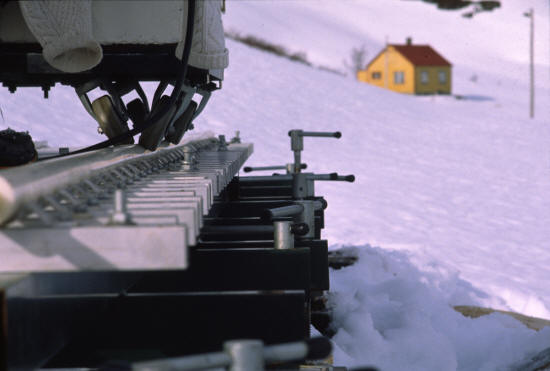 Close
up of the flexible bendable
plastic rails on aluminium sleepers placed rails of solid steel. Picture:
Camera Magica Close
up of the flexible bendable
plastic rails on aluminium sleepers placed rails of solid steel. Picture:
Camera MagicaTHa: How did this work with a 65mm camera on rail, advancing frame by frame? Morten: We devised this system with five very flexible rails, four of them were 2 meters long, plus we made a short length of 1,5 meters. The rails themselves were bendable plastic profiles, which we mounted on aluminium sleepers. The rail on one side was loose, so we could fix it in different positions, because in curves - one rail becomes longer than the other one. We placed those rails on solid steel tables, which we would lay out first. In the summertime, much of the time we could lay out those steel tables directly on the ground. But during the winter, we had to shovel a lot of snow and pound the snow underneath as hard as we could, before placing wooden planks and boxes to support the steel tables. The camera wagon consisted of an upper part and a lower part, so we could move the upper section around freely as we panned the camera. We had a front hatch to photograph through and a side hatch on the left side for operating the camera and the other things. Each time we had panned the camera over so much that we risked seeing the hatch opening, we just moved the upper part around a bit to keep it out of shot. That rig was quite flexible. We had a Crass stop motion stand with a good crank head for tilt and pan, and a manual levelling system under it to keep the base perfectly level at all times. A land measuring instrument was connected to the pan head for adjusting the horizontal angle. The tilt- and pan axis had an accuracy of one hundredth of a degree, while the forward movement had an accuracy of 1 millimetre. Then we used a computer to calculate the forward movement along the rails. It was an early but quite solid Amstrad computer, with a steering programme especially made for us. That would keep track of the shooting positions for every film frame, and also steer an electric motor that advanced the camera forward to the next shooting position each time a frame was taken. When I programmed a new acceleration, or more frames with a constant speed, the computer would make a long list of shooting positions for each frame. Then I could compare this with the set of 300 measuring photos we had taken the previous autumn, and see if it looked right or not. For instance if we had been moving 15 centimetres per frame for a while and then I wanted to increase the speed to 25 centimetres per frame starting the acceleration when we were in the middle of a curve in the road ahead of us, I would find the start frame for the acceleration by comparing the position data with the measuring photos, and then program the acceleration over a number of frames from there. Then again I would look at the next measuring photos and compare to the position for the end of the acceleration to see if that looked right, and maybe adjust it till it looked good, before I programmed a number of frames after that at a constant speed of 25 centimetres per frame. So we could plan really exactly ahead. If I saw that we needed some more frames for adjusting the pan for instance, then I could compensate by starting the acceleration later, and always be able to check with the measuring stills what it would look like. The computer was very handy for forward movement. The other moves, we had to do manually. The levelling was done by one in the team after each forward move, then I did tilting and panning manually with the crank head, and used the land measuring instrument to adjust after sight points in the landscape for correct positioning. Each time we needed to make a tilt or pan, I wrote tables on paper beforehand with positions for each frame. The computer and other apparatus needed 230V electricity, and we had an oven in the lower part to keep things warm. It was also nice to have a place to warm our hands when it was cold. We laid out lots of cables. There was mains electricity available most of the time, and sometimes we used a generator. |
|
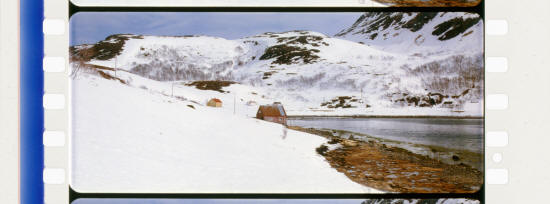 THa:
Why did you decide to shoot it in 65mm? THa:
Why did you decide to shoot it in 65mm? Morten: Oh! That had been an old dream! One of the things that I loved about my childhood and youth was going to the Colosseum cinema in Oslo, which had this huge, vast screen and they showed these big, fantastic 70mm films and had those magic DP70 70mm projectors behind. It made a big impression to see those films, and I had dreamed about making 70mm film myself ever since. The Børfjord film was definitely an idea suited for 70mm. It needed a big picture on a big screen with lots and lots of details. Rune Ericsson in Sweden was an agent for Panavision at that time and also worked with the Norwegian camera rental company ScanCam, he helped me get in contact with Panavision in Los Angeles. Panavision also liked the idea and said,
So it was just a fantastic deal! The camera
was basically a 65mm Mitchell camera which had been modified for
Panavision,
it was the old rack over type, which had no through the lens viewing when
shooting. It had a side viewfinder for viewing when shooting, and when we
were not shooting, we could rack over the central camera part to the side
for exact checking of the the picture through the lens. It was an old
system, but it was just perfect for our use! |
|
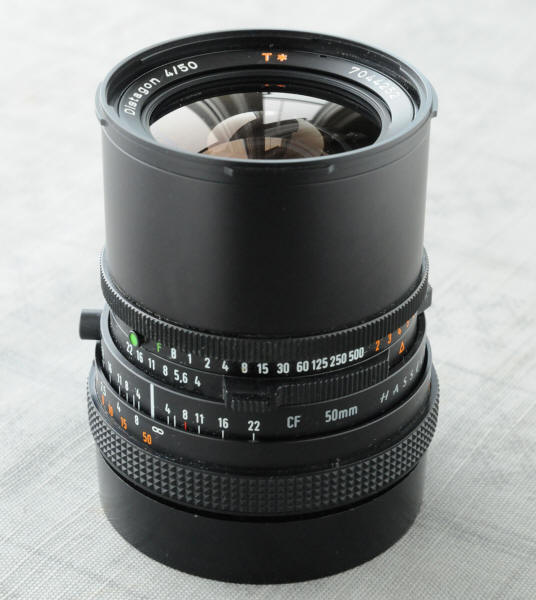 The
50mm Hasselblad Zeiss lens used for shooting "A Year Along the Abandoned
Road". The same lens was later also used on Morten Skallerud's large format
short film "Where the Trains Used to Go" and Ole Mads Vevle's 70mm short
film "Tanakh Bibelen al-Quran". Picture: Morten Skallerud The
50mm Hasselblad Zeiss lens used for shooting "A Year Along the Abandoned
Road". The same lens was later also used on Morten Skallerud's large format
short film "Where the Trains Used to Go" and Ole Mads Vevle's 70mm short
film "Tanakh Bibelen al-Quran". Picture: Morten SkallerudTHa: What kind of problems did you have with the camera if any? Morten: Not many, that was just a great camera. One small practical thing was that we had 500 feet magazines, whilst the raw film came in 1000 feet rolls, so I had to spool in a dark room and split the stock into two rolls - but that was no problem. It was a stable camera which functioned really well. We had basic heating for it and it never became too cold. No, I don't think we had any camera problems. THa: I suppose you only used one lens? Morten: Yes, since it was basically one shot. I bought a 50mm Hasselblad Zeiss T4 lens and had a conversion mount made to fit on the Panavision mount. It was basically used with an aperture stop of around T8 - T11 most of the time. THa: It was very well stopped down. Morten: Yes. You know in general lenses are always best around the middle of their aperture scale. But for the night part we opened up to full aperture T4, and the lens performed very nicely there too. THa: When the film was finished, after a long production time... Morten: ....and after a long waiting time, because we ran out of money [laughs]... |
|
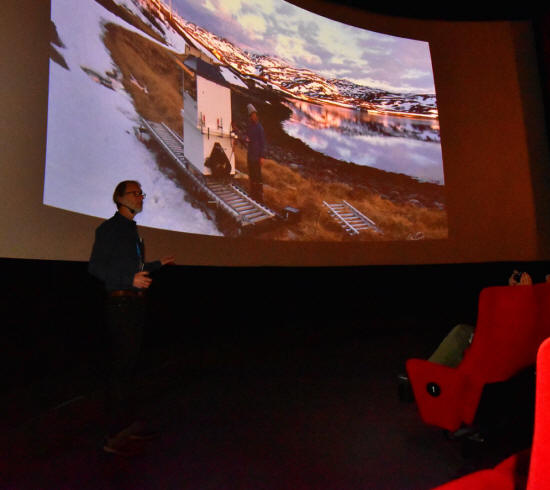 "I
was the first person to make tracks in the snow. There were more and more
abandoned houses, and this grand nature around, it gave me a very strong
feeling right in my stomach. That feeling I had then, was one of the things
I wanted to recreate in the film. That feeling of just passing through those
very wonderful places, those fallen down places and no trace of human
activity." "I
was the first person to make tracks in the snow. There were more and more
abandoned houses, and this grand nature around, it gave me a very strong
feeling right in my stomach. That feeling I had then, was one of the things
I wanted to recreate in the film. That feeling of just passing through those
very wonderful places, those fallen down places and no trace of human
activity."THa: ...how much did it cost to make it? Morten: Oh! I've forgotten the sum ... somewhere around a million Norwegian Kroner, a bit more, and that was thirty years ago. In addition, we got lots of help for free and lots of labour credits. We had set the budget all too low, and after some time when we saw how much time this took to shoot, we all started to work on labour credits. The shooting team had a portion of their payment as labour credits, and I myself worked on 100% labour credit, without a salary. I look up private loans to afford to continue. We had quite some problems financing the last part of the shoot. Luckily we had some income from the film after it was finished, so by 2002 I was able to pay back all the labour credits. Of course, we were making film in a new way, and before we started it we could only guess how much time the shooting would take, how fast we could work in different conditions and things like that. And it took a lot more time than we had guessed. We ended up with around a hundred and eighty working days, between March 1988 and January - February 1989, out of which we exposed frames in the camera one hundred and five out of those days. So it was quite a number of working days. When we were moving on the rails we shot an average of six seconds per day round 140/150 frames average. Some days we took much less. Some days, especially in the summer, when things were easy, we shot a lot more. Then when we were standing still, like on the ferry bridge, then we shot a lot more, when we were just panning, or panning and tilting and not moving on the rails. THa: Does that mean you left the camera and went home between shooting days, or did you take the camera off the rails, into storage? How did you find the exact spot to continue? Morten: We always left the camera wagon to stay there. From one day to the next, we just locked the hatches, because we had good locks. When we went away for more than just a night, then we took the camera off. We left the camera wagon, with the Crass stand and the computer etcetera inside, and took off the camera and the land measuring instrument and brought it with us to a safer place. And when we came back we put it back up. Lots of measures had to be made when we left, both with a measuring tape and with the land measuring instrument. We took lots of notes with measures in all directions, thus we would always be able to find back to the correct positions and angles. Luckily, nothing happened to the wagon those times when we were away. But if it had happened, since we had all those notes, we would have been able to go back to at least approximately the same place, within a couple of centimetres. THa: I always imagine that you would leave the camera wagon on a dark night and there would be a snowstorm whipping the camera away and dumping it in the fjord - that never happened? Morten: That never happened because the camera house was quite heavy. So it would need to be a very heavy storm to move it. When we left, we always had the camera wagon on one length of rail, with some extra strapping just to be sure, while the rest of the rails were placed somewhere else. We were as safe as we could be in case of a storm. |
|
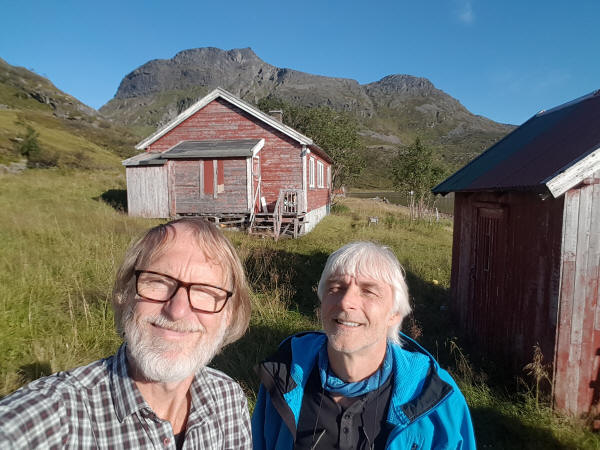 Morten
Skallerud and central team member Knut Skoglund back in Børfjord 2018, at
the place where the film starts. Since 1988, the white house had changed
colour and the shed had been rebuilt. Picture: Morten Skallerud Morten
Skallerud and central team member Knut Skoglund back in Børfjord 2018, at
the place where the film starts. Since 1988, the white house had changed
colour and the shed had been rebuilt. Picture: Morten SkallerudTHa: When the film was finished, how did it live up to your expectations? Morten: Quite well. We had managed to do almost everything as we had planned, plus there were many details that had added themselves during the shooting because of the weather and the place itself and all the nice people we met there. Also, we had got so much positive response during the whole process, all the way from the very beginning when we had just made a test film, then through the shooting period when we could show a more and more complete workprint, and till the end when we could show a more or less finished film. We in the team believed very strongly in the project, and it seemed like everyone around us meant the same. There was a positivity around the whole production, which was overwhelming. After we had done the first period of three weeks shooting, we sent the film to be developed at Metrocolor in Los Angeles, and ordered a rush print both in 35mm and 70mm. For them we were obviously a low-priority customer, so it took a month before we got the rush-prints back. A terror to wait that long, especially since we couldn't continue shooting before we had seen it. But it looked very good, so we could continue shooting. Then as we went on, each time we got back a new piece of work print, we spliced it onto the film roll and had new screenings. Luckily, it looked good every time. After the shooting, we were completely out of money. I earned my money on other film jobs, and two years later luckily we also got some more finances for the Børfjord film. By 1991, we could at last afford to finish the film in a proper way. By then the Technicolor laboratory in London had started doing 70mm again, so we could do the finishing of the film there, that was great. And best of all, Jan Garbarek, who hadn't had available time when we finished shooting in '89, he had got time again now and said Yes to make the music for the film! We recorded his music at Rainbow studios in February, then Jan Lindvik finished the sound job, Technicolor did a very good lab job, and the film had its premiere, in 35mm, at the Norwegian Short Film Festival in Grimstad in June, where it also got its first festival prize. THa: Did you know Jan Garbarek before that? Morten: Yes, we had talked together several times, and we had worked together on some films - first a feature film and then a short film I photographed and for which he wrote the music. I invited him to a work print screening of the Børfjord film in 1988 and he gave some very nice feedback. It made me very happy when he finally said "Yes" to make the music. He has done a marvellous job. It's a beautiful score, so real, so basic, so wild, so melodic, like it takes in the whole big nature around. It goes so well together with how we move through the village. His music takes in both the place and the moods and the way we move. Not only does it match the pictures perfectly, but there is also so much much extra to it. |
|
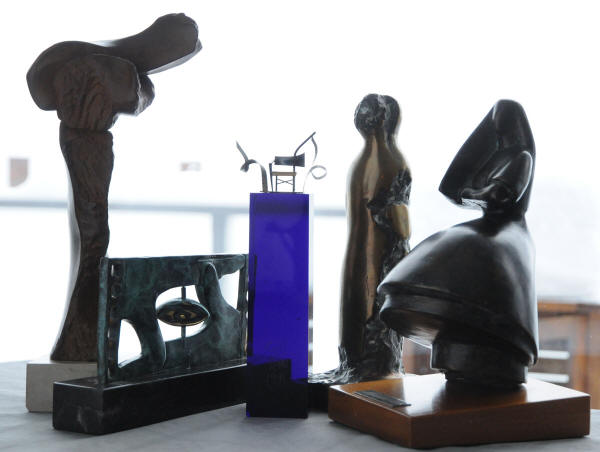 Five
of "A Year Along the Abandoned Road"'s 12 prizes, left to right: Odense-93,
Madrid Imagen-98, Grand Prix "Golden Chair" Grimstad-91, Grand Prix
Tampere-92, Amanda-91. Picture: Morten Skallerud Five
of "A Year Along the Abandoned Road"'s 12 prizes, left to right: Odense-93,
Madrid Imagen-98, Grand Prix "Golden Chair" Grimstad-91, Grand Prix
Tampere-92, Amanda-91. Picture: Morten SkallerudTHa: I saw the film at Panavision in 1994 with Tak and Mikael Salomon, the Danish cinematographer. Mikael Salomon was very impressed with your horizon, and how stable and completely rock steady it was. Have you received any similar feedback from your peers in the business about the beautiful look and technique? Morten: Yes many times. Some of the comments are about the perfection of the technique. Of course, the technique had to be perfect. If the technique had not been perfect, the audience would start thinking about the technique instead of thinking about what they saw and the place and the impression and the mood and what happened. Many of my cinematographer colleagues have been talking very nicely about it, and some great film directors who I have met at film festivals, like Nikita Mikalkov and Ron Fricke. In 2003 when digital colour grading was at an early stage, there was a seminar in Oslo led by Peter Doyle who was one of the inventors and pioneers, and who also worked on the "Lord of the Rings" films. He also saw the Børfjord film and liked it, and asked if he could borrow a 70mm print and show it to some of the crew back in New Zealand. We lent him a print and he had a screening for many of their camera crew and VFX people and producers. After that I got a very nice letter from their brilliant director of photography Andrew Lesnie. I appreciated that a lot! Some times I have taken a print with me on visits abroad, to places like Aardman Animations, Boss film and ILM [Industrial Light and Magic], these were fantastic places to see, with great people who do great things, and the response on the Børfjord film was always good. THa: When it first came out [in 1991] it was submitted to many festivals, and won many prizes. Morten: It's still at some festivals now and then - even right now here at the Schauburg! It surpassed the number of 300 festivals a couple of years ago, and has won 12 major prizes. Of course, nowadays, that is not very much. But in the '90's that was quite a lot. |
|
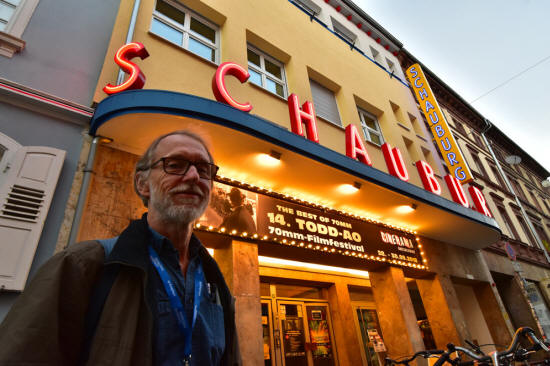 "It's
very nice to be here at the Schauburg [Karlsruhe, Germany]! It's such a
beautiful cinema and that curved screen! I also look forward to having my
Børfjord film shown here, it is the first time I have seen it myself projected on
such a deeply curved screen. It is fantastic to see all these great 70mm
films on that curved screen, in this beautiful theatre with very good
quality of picture and sound!" "It's
very nice to be here at the Schauburg [Karlsruhe, Germany]! It's such a
beautiful cinema and that curved screen! I also look forward to having my
Børfjord film shown here, it is the first time I have seen it myself projected on
such a deeply curved screen. It is fantastic to see all these great 70mm
films on that curved screen, in this beautiful theatre with very good
quality of picture and sound!"THa: How should the audience see the film today? Should they see it in 4K or 70mm? Which do you prefer? Morten: A 70mm print is definitely the best, and 4K digital cinema is second best. 35mm is a good number three. All three are good, but with 2K digital cinema you lose much of the details. I think in general, 2K digital cinema is a bad compromise. Digital cinema has very good colours, but the 2K pictures don't have much more detail than a normal TV in people's homes nowadays. But 4K cinema can be really good, it compares well to 35mm film prints struck directly from original negatives. Yet, even good 4K doesn't include all the details and all the finesse of 70mm projection. The 4K DCP of the Børfjord film is really fine. It was scanned to digital format from the 65mm interpositive by FotoKem in Los Angeles, they have an 8K scanner which renders excellent 4K, and some really clever people who do a great job. THa: If people want to show the film today, how do they do it? Do they contact you? Morten: They can contact the Norwegian Film Institute or they can contact me. Jan Olsen at the Norwegian Film Institute is the guy who takes care of 70mm prints, in a very good way. But Toril Simonsen is the one to ask, she leads the section for distributing short films abroad. Sometimes people contact Toril and sometimes they contact me. THa: Can they show any version of the film they wish for 35mm or 70mm or 4K? Morten: 4K or 35mm are the easiest options. Very few festivals show 70mm, and also a 70mm print is impossible to replace if something happens to it, so 70mm is normally not lent out at all. 35mm is a lot easier, but it's not very often that 35mm analog prints are being screened anymore either. THa: Any final comments? Morten: It's very nice to be here at the Schauburg Cinerama [Karlsruhe, Germany]! It's such a beautiful cinema and that curved screen! I also look forward to having my Børfjord film shown here, it is the first time I have seen it myself projected on such a deeply curved screen. It is fantastic to see all these great 70mm films on that curved screen, in this beautiful theatre with very good quality of picture and sound! |
|
| Go: back - top - back issues - news index Updated 22-01-25 |
